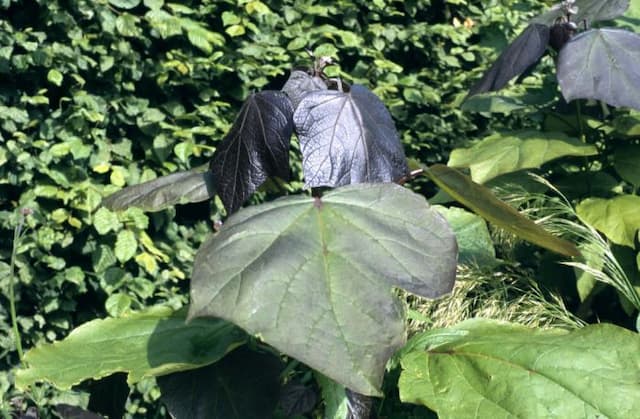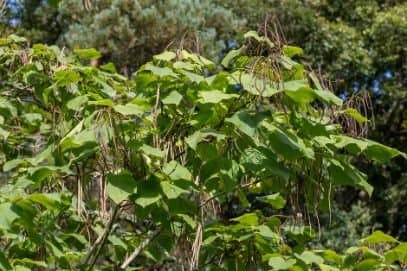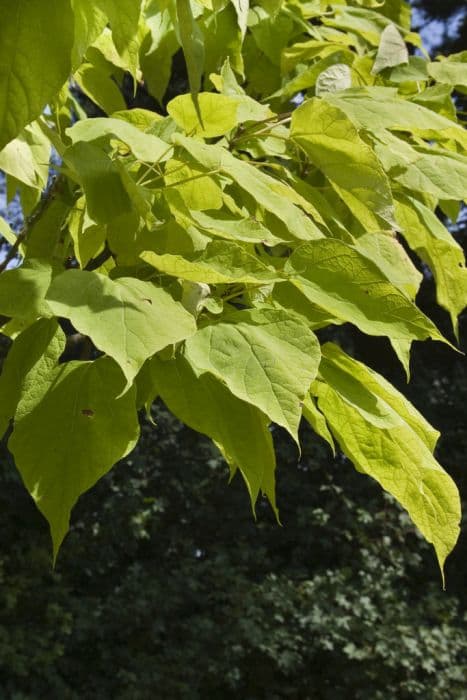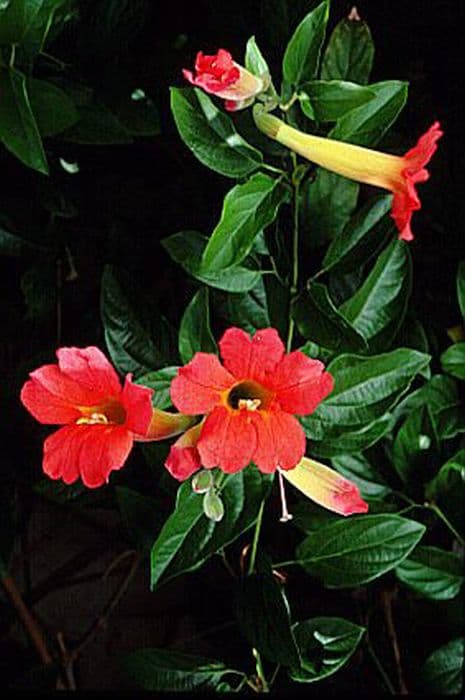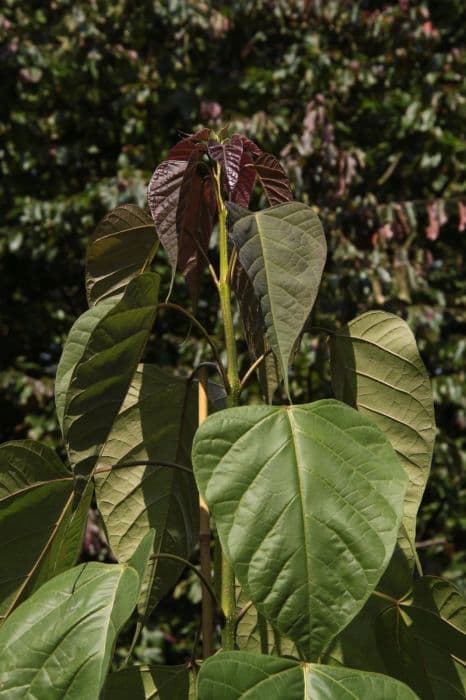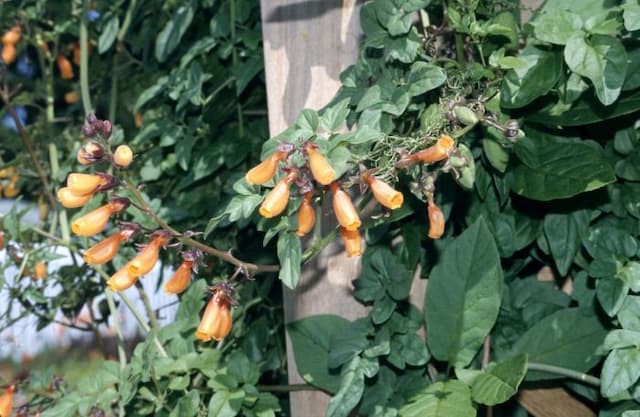Northern Catalpa Catalpa speciosa 'Pulverulenta' (v)

ABOUT
Catalpa speciosa 'Pulverulenta', commonly referred to as the Northern Catalpa, is a striking ornamental tree favored for its unique appearance. This variety is noted for its large, heart-shaped leaves that have a distinct appearance. The leaves are speckled or variegated, usually with creamy white or yellowish spots against a green background, giving the foliage a look as if it has been dusted with powder. During the blooming season, the Northern Catalpa produces clusters of showy and fragrant flowers. The flowers are bell-shaped, white with purple and yellow markings inside, and they are arranged in large, upright panicles. These blooms add a dramatic display and are a nectar source for bees and other pollinators. After flowering, the tree develops long, slender seed pods that hang down from the branches. These pods can be quite conspicuous, resembling slender beans, and they persist into the winter, offering a unique visual interest even after the leaves have dropped. The bark of the Northern Catalpa is also noteworthy. It is relatively thick, ridged, and furrowed, providing textural contrast to the landscape throughout the year. With its variegated foliage, decorative flowers, and distinctive seed pods, the Northern Catalpa presents a bold statement in any garden or landscape setting, bringing a combination of seasonal beauty and architectural form.
About this plant
 Names
NamesFamily
Bignoniaceae
Synonyms
Nana Variegated Northern Catalpa, Variegated Northern Catalpa
Common names
Catalpa speciosa 'Pulverulenta' (v).
 Toxicity
ToxicityTo humans
The Northern Catalpa is generally considered to be non-toxic to humans. However, it's always best to exercise caution and avoid ingesting parts of ornamental plants as a general safety rule. There is limited information on the specific 'Pulverulenta' variety, but the Northern Catalpa tree, in general, does not have a reputation for being poisonous. While eating parts of this tree is unlikely to cause harm, it's not recommended due to potential individual allergies or gastrointestinal discomfort.
To pets
The Northern Catalpa is also not known to be toxic to pets. Pets, like cats and dogs, typically do not have adverse reactions to this tree. However, as with humans, eating non-food plants can potentially lead to gastrointestinal upset in some pets. If an animal ingests a large amount of plant material, it could possibly cause obstruction or other issues, though this is not specific to the Northern Catalpa's toxicity. Owners should still prevent pets from chewing on the tree to be cautious.
 Characteristics
CharacteristicsLife cycle
Perennials
Foliage type
Deciduous
Color of leaves
Green
Flower color
White
Height
40-60 feet (12-18 meters)
Spread
20-40 feet (6-12 meters)
Plant type
Tree
Hardiness zones
4
Native area
North America
Benefits
 General Benefits
General Benefits- Shade Provider: The large leaves and dense canopy of the Catalpa tree offer significant shade, making it ideal for parks and garden landscapes.
- Ornamental Value: With its showy, white flowers and unique foliage, the Northern Catalpa serves as an attractive ornamental plant.
- Attracts Wildlife: The flowers provide nectar for pollinators, while the tree can host Catalpa Sphinx caterpillars, which in turn attract birds.
- Durable Wood: Northern Catalpa wood is resistant to rot, making it useful for outdoor applications like fence posts and railway ties.
- Tolerance to Adverse Conditions: It is able to withstand urban conditions, including air pollution and poor soil, and thus is a sturdy choice for city planting.
- Seasonal Interest: With its springtime flowers, dense summer foliage, and long, dangling seed pods in the fall, it provides year-round interest.
 Medical Properties
Medical PropertiesThis plant is not used for medical purposes.
 Air-purifying Qualities
Air-purifying QualitiesThis plant is not specifically known for air purifying qualities.
 Other Uses
Other Uses- Catalpa speciosa 'Pulverulenta', commonly known as Northern Catalpa, can be used as a natural dye source where different parts of the tree, such as leaves or bark, can be processed to extract colorants.
- The wood of Northern Catalpa is resistant to rot and decay, making it suitable for fence posts, railroad ties, and outdoor furniture where durability is essential.
- Fishing enthusiasts sometimes use the long, bean-like seed pods of Northern Catalpa to make whimsical fishing lures due to their buoyant properties and interesting shapes.
- The large leaves of the Northern Catalpa can be used in art projects for leaf printing or nature-inspired designs where textures and patterns are desired.
- Northern Catalpa is occasionally used in woodworking and carpentry to create unique, decorative veneers with the distinctive wood grain of this species.
- During winter months, the dense canopy of a leafless Northern Catalpa tree can act as a natural snow fence, reducing snow drift on properties.
- Northern Catalpa trees can be planted in a row to create a windbreak, helping to reduce wind speed and protect smaller plants or erosion-prone areas.
- With its broad canopy, Northern Catalpa provides ample shade which can be used to naturally cool buildings and reduce air conditioning costs in the summer.
- The flowers of Northern Catalpa, when in bloom, are used in decorative arrangements and could potentially be used in eco-friendly confetti.
- Some communities plant Northern Catalpa as a commemorative tree for its longevity and the substantial, stately presence it offers to public spaces.
Interesting Facts
 Feng Shui
Feng ShuiThe Northern Catalpa is not used in Feng Shui practice.
 Zodiac Sign Compitability
Zodiac Sign CompitabilityThe Northern Catalpa is not used in astrology practice.
 Plant Symbolism
Plant Symbolism- Endurance: The Catalpa tree is known for its hardiness and its ability to withstand tough conditions. This makes it a symbol of endurance and perseverance.
- Uniqueness: The variegated leaves of the 'Pulverulenta' variety of Catalpa speciosa stand out, representing individuality and the beauty of being different.
- Fertility: With its long seed pods, the Catalpa tree often symbolizes fertility and abundance.
- Protection: The tree’s large, spreading canopy offers shelter and shade, making it emblematic of protection and care.
- Transformation: The Catalpa tree, with its distinct seasonal changes—from flowering to seed production—embodies the idea of transformation and change.
 Water
WaterThe Northern Catalpa should be watered deeply and thoroughly once a week during its growing season, especially during dry spells, allowing the soil to dry out between waterings. In the absence of rainfall, provide about 1.5 to 2 gallons of water spread evenly around the root zone. During the winter months or dormancy period, reduce the frequency of watering to coincide with lower temperature and growth rates, keeping the soil consistently moist but not waterlogged.
 Light
LightThe Northern Catalpa thrives best in full sunlight to partial shade. The ideal location would allow it to receive at least six hours of direct sunlight daily, which promotes healthy growth and flowering. It can tolerate some shade, but too much can lead to reduced blooming and a less robust tree.
 Temperature
TemperatureThe Northern Catalpa is hardy and can withstand a broad range of temperatures; it is comfortable in temperatures as low as -30°F and can tolerate heat above 100°F. The ideal temperature range for optimal growth is between 60°F and 80°F.
 Pruning
PruningPrune the Northern Catalpa to maintain its shape, remove any damaged or diseased limbs, and to promote air circulation. Pruning is best done in late winter or early spring before the tree begins its rapid growth cycle. It's generally recommended to prune every two to three years, focusing on thinning dense branches rather than heavy cutting back.
 Cleaning
CleaningAs needed
 Soil
SoilThe Northern Catalpa requires well-draining soil rich in organic matter, with an ideal pH range of 5.5 to 7.0. A soil mix containing loam, compost or aged manure, and a smaller amount of sand or perlite allows for good root growth and adequate drainage.
 Repotting
RepottingNorthern Catalpa trees, being large and fast-growing, do not typically need repotting as they are usually planted directly in the ground. Young trees should be transplanted before they reach a large size.
 Humidity & Misting
Humidity & MistingNorthern Catalpa trees are adaptable but prefer average humidity levels. They can tolerate some variation, but extreme changes in humidity should be avoided.
 Suitable locations
Suitable locationsIndoor
Not suitable for indoor growth due to its large size.
Outdoor
Plant in full sun, well-drained soil, and water regularly.
Hardiness zone
4-8 USDA
 Life cycle
Life cycleThe Catalpa speciosa 'Pulverulenta', commonly known as the Variegated Northern Catalpa, begins life as a seed which germinates in the spring. Following germination, the seedling stage involves establishing roots and producing its first set of true leaves. As it enters the vegetative stage, the catalpa develops a strong stem and a canopy of large, heart-shaped, variegated leaves which are the plant's hallmark. During the reproductive stage, typically occurring in mature trees, the Northern Catalpa produces clusters of white flowers which are followed by long, bean-like seed pods that mature by fall. These pods eventually open to disperse seeds before the tree enters dormancy in winter. Throughout its life, the Northern Catalpa may experience multiple cycles of flowering and seed production, typically living for several decades with proper care and favorable conditions.
 Propogation
PropogationPropogation time
Spring-Early Summer
The Northern Catalpa 'Pulverulenta', a variegated cultivar of Catalpa speciosa, is typically propagated through seed sowing or cuttings, with the latter being the most popular method. For propagation by cuttings, semi-ripe wood from the current season's growth is selected in late summer. A cutting of about 4 to 6 inches (10 to 15 centimeters) is taken with several leaf nodes, and the leaves on the lower half are removed. The cut end is often treated with a rooting hormone to encourage root development and then planted in a mixture of peat and perlite to provide an ideal rooting environment with good drainage and aeration. The cutting should be kept moist and in a warm environment with indirect light until roots have established, after which it can be gradually acclimated to outdoor conditions and eventually planted in its permanent location.
